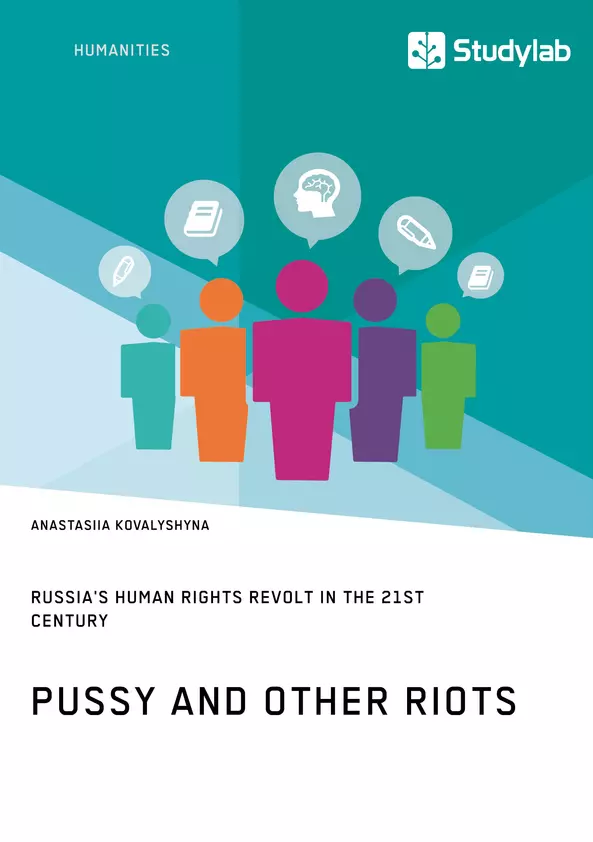Contemporary Russia, despite her official status as a “modern democracy”, casts great doubt on her “legitimacy”. Putin “tolerates” the fundamental human rights principles, but how freely can Russian citizens really speak? What is Russia’s stance on the matter of human rights and freedoms in comparison to the European traditions? And how do the current Russian “crack down” actions influence on her foreign policy with the other nations?
The focus of this book is both on revealing the nature of the declared normative human rights principles in Russia, and a more substantial analysis of the practical cases, identifying the general dynamics of human rights violations in 21st century Russia.
From the text:
– Historical background;
– Human rights;
– The case of Pussy Riot;
– Free Speech;
– The duality of coercion
Table of Contents
- Introduction
- Chapter 1: From the Past to the Present
- 1.1 State and Individual: "The Right to Swing the State's First Ends Where the Man's Rights Begin?"
- 1.1.1 The Definition, The Reasons and Some Methodological Controversies: the relationship between the power of state and the rights of individual in the context of the global international affairs.
- 1.1.2 State and individual: who governs whom?
- 1.1.3 Where do the people's rights begin and the state's authority end? Historical prospection from the European experience.
- 1.1.4 How the state can be controlled by people themselves: system of mechanisms and regulations...
- 1.2 Is It Possible to Make Russia Less Violent and More Liberal? Or How Did Russia Understand "The Rights of Others” in Her Historical Discourse?
- 1.2.1 What are the origins of human rights in Europe and Russia? and how do they understand them?
- 1.2.2 State in power: people's friend or enemy?
- 1.2.3 Where is the root of the European and Russian diversity and where is the common ground of their resemblance?
- 1.2.4 Living in the bipolar world: communism and human rights……………………
- 1.2.5 Living in the Post-Communist times. Whether is Russia ready to ensure her citizens with the basic political and civil human rights principles?
- Chapter 2: Freedom of Speech in Modern Russia. The Pussy Riot's Case. The Victims of a Political Prosecution or the Hooligans, who Harshly Disrupt Public Order?
- 2.1 Political resistance or devil's dances?
- 2.2 Detention. Birds in a cage...
- 2.3 The “tragicomedy\" starts. Prelude......
- 2.4 Trial. The scene number 1
- 2.5 The scene number 2. Culmination.....
- 2.6 Final stages. Appeal to the Moscow City Court. Verdict number 2..
- 2.7 Completion. The imprisonment..
- 2.8 Aftermath. The stage is closed: contrition or simply PR? ..
- 2.9 The eternal question: Who is guilty? and what to do?
- 2.10 In search of the Investigators........
- 2.11 Victims or "Spiritual Judges".
- 2.12 Vladimir Putin and Pussy Riot.
- 2.13 Conclusions. Who is guilty and for what? ..
- Chapter 3: The Duality of Coercion in Russia: Cracking Down on „Foreign Agent\"
- 3.1 How coercion really works in Russia? System of carrot and stick...
- 3.2 The Duality of \"the Foreign Agent Law\".
- 3.3 Some sort of discrimination.........
- 3.4 How does the state administration constrain NGOs? Reprisals in practice.....
- 3.5 The court proceeding over “the suspicious NGOs”. USAID and “Golos” examples ...
- 3.6 Conclusions.
- The relationship between state power and individual rights in Russia
- The historical development of human rights in Russia and Europe
- Freedom of speech and political dissent in contemporary Russia
- The impact of the "Foreign Agent" law on civil society and non-governmental organizations
- The challenges of promoting human rights and democracy in Russia
Objectives and Key Themes
This study analyzes the state of human rights in contemporary Russia, focusing on the relationship between the state and the individual. It examines the evolution of human rights discourse in Russia, highlighting the historical and political factors that have shaped its current status. The study explores the complexities of freedom of speech, particularly through the case of the Pussy Riot group, and investigates the impact of the "Foreign Agent" law on non-governmental organizations. Key themes include:Chapter Summaries
Chapter 1 explores the historical and theoretical context of the relationship between the state and the individual in Russia. It examines the origins of human rights discourse in both Russia and Europe, highlighting the divergent paths these societies have taken. The chapter analyzes the development of human rights principles in Russia, particularly in the context of the Soviet era and the post-communist transition. Chapter 2 examines the case of the Pussy Riot group, focusing on the complexities of freedom of speech and political dissent in contemporary Russia. It analyzes the legal proceedings against the group, the political context surrounding their actions, and the broader implications for freedom of expression in Russia. Chapter 3 investigates the impact of the "Foreign Agent" law on non-governmental organizations (NGOs) in Russia. It explores the mechanisms of coercion employed by the state, the legal framework of the law, and its practical consequences for NGOs. The chapter examines specific cases, such as the USAID and "Golos" organizations, to illustrate the challenges faced by NGOs operating in Russia.Keywords
The primary focus of this work lies on the relationship between state power and individual rights in Russia. It examines the historical and political factors that have shaped the current state of human rights in the country. Key terms include: human rights, freedom of speech, political dissent, civil society, non-governmental organizations, "Foreign Agent" law, coercion, state power, individual rights, Russia, Europe, historical development.- Citation du texte
- Anastasiia Kovalyshyna (Auteur), 2015, Pussy and Other Riots. Russia's Human Rights Revolt in the 21st Century, Munich, GRIN Verlag, https://www.grin.com/document/351347



